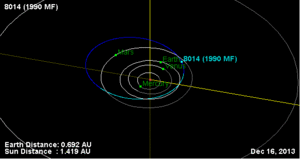(8014) 1990 MF
From Wikipedia, the free encyclopedia
 Orbit of 8014 | |
| Discovery | |
|---|---|
| Discovered by | Eleanor F. Helin |
| Discovery site | Palomar Observatory |
| Discovery date | June 26, 1990 |
| Orbital characteristics | |
| Epoch November 4, 2013 | |
| Aphelion | 2.5426 AU (380.37 Gm) |
| Perihelion | 0.9506 AU (142.21 Gm) |
| Semi-major axis | 1.7466 AU (261.29 Gm) |
| Eccentricity | 0.4557 |
| Orbital period | 2.31 yr |
| Mean anomaly | 23.972° |
| Inclination | 1.8647° |
| Longitude of ascending node | 210.41° |
| Argument of perihelion | 114.16° |
| Proper orbital elements | |
| Proper mean motion | 0.4267 deg / yr |
| Proper orbital period |
843.68409 yr (308155.613 d) |
| Physical characteristics | |
| Dimensions | 700 m (2,300 ft) |
| Absolute magnitude (H) | 18.7 |
|
| |
(8014) 1990 MF is a near-Earth minor planet in the Apollo group. It was discovered by Eleanor F. Helin at the Palomar Observatory in San Diego County, California, on June 26, 1990. This object is approximately 0.7 kilometres (0.43 mi) in diameter, and listed as a potentially hazardous object.[1] On July 23, 2020, it will come within 0.055 au of the Earth—about 21.3 times the Moon's distance.[2]
See also
References
- ↑ "JPL Small-Body Database Browser - 8014 (1990 MF)". JPL Small-Body Database. NASA. Retrieved November 14, 2011.
- ↑ Nieuwenhuizen, Bas (June 22, 2011), Asteroid 8014 (1990 MF) Earth Flyby at 0.055au, Zapaday, ISBN 0745649742, retrieved 2013-02-16.
| |||||
| ||||||||||||||||||||||
This article is issued from Wikipedia. The text is available under the Creative Commons Attribution/Share Alike; additional terms may apply for the media files.